Bird of paradise are hard to find, but harder still are the slippery slopes of West Papua forests. Simon Pridmore puts on his trekking boots to discover the wild and wilderness of West Papua and describes his quest for the lesser bird of paradise.
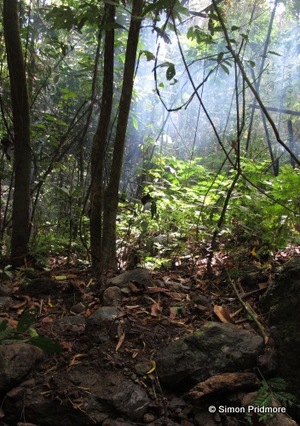
Morning in the Papuan forest, sun breaks slowly and birds sing.
Bali, 5 June 2013. We were already half way up the first hill when dawn broke over Cenderawasih Bay behind us. The steep angle of the slope and the foliage covering the forest floor made for hard going but here and there, where the incline was especially steep or the path came perilously close to the edge, the villagers had placed bamboo railings.
Stakes were driven into the forest floor and lengths of green bamboo were lashed to them using a vine with the strength and consistency of cured leather. Shorter angled stakes at closer intervals served as footholds.
In places where the makeshift railing had broken, the guide leading us would stop us with a raised hand, slash a new length of vine and a fresh bamboo pole from the surrounding forest and lash these together expertly before motioning us to continue. A new three-metre length of rail took him only seconds.
Our small team quickly broke into two parts; Sofie, our local friend Charles Roring and the head guide from the village led the way. I followed some distance behind, heading a second three-person group with the lead guide’s five-year-old daughter and his assistant. The villagers were barefoot, the rest of us were wearing inadequate sandals.
We passed through a makeshift overnight camp of faded tarpaulin slung over a frame and sheltering a series of bamboo trestles and reached a stream where we left the assistant and the little girl behind to set up a day camp, while the rest of us continued our climb, up the stream bed this time, a rocky route even more slippery and fraught with peril than the forest trail. At one point a three-step bamboo ladder had been erected mid-stream to help us climb over a small vertical waterfall.
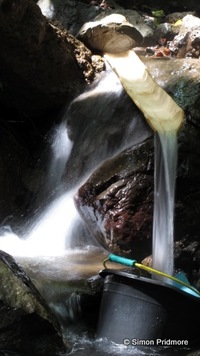
Collecting water from the stream.
From the top of the waterfall we passed on through dense undergrowth and past massive trees that spread out above us to form a canopy through which light filtered intermittently. Noticing that our guide was treading more carefully, we attempted to imitate him but failed miserably. While he managed to move noiselessly among the dry leaves and rotten twigs that littered the ground, despite our best efforts we only succeeded in taking the worst possible option with every step. We felt like clumsy city-folk and winced with shame at every crunch and crackle underfoot.
Beneath a huge tree, our guide paused and crouched, looking up through a hole in the canopy. We followed his pointing finger with our eyes and there, in the topmost branches was the unmistakeable luxuriant yellow and white plumage of a lesser bird of paradise. Then we saw another; they were moving constantly, hopping back and forth.
We could now connect the unique, loud, plaintive call that we had been hearing above the other noises of the forest with its author. A small shelter of palm fronds had been placed in the lower branches of the tree to shield us from the birds’ view. We sat below this and peered upwards, watching and listening intently. These birds are so hard to find in the wild, so rarely spotted and our guide had managed to place us under the very tree where they were roosting at this time of day. He explained that they came here to eat the fruit that grew on the higher branches, that they would leave around 9 a.m. and return around 1 pm.
We were sceptical that wildlife would follow such an exact schedule, arranged conveniently around the top of the hour but, sure enough, at 9 prompt a crashing of wings and more distant cries accompanied the departure of the birds of paradise and we made our way carefully back down the slope and the rocky river bed to the pool where the day camp had been set up. A bamboo pole had been slashed lengthways to fashion a water culvert that redirected part of the river over a small easily accessible ledge and a kettle was boiling gently away over a small fire set into a niche in the rocks.
Bird Species in West Papua
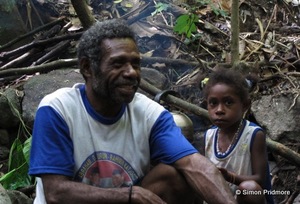
Our West Papuan guide and his daughter led us to view hornbills and lesser birds of paradise.
We sat on the rocks, had tea and noodles, chatted generally about the forest and its inhabitants and watched a succession of glorious butterflies flitting about. The lesser birds of paradise are relatively widespread in West Papua but desperately hard to find. Twenty-nine out of the world’s 43 known species of bird of paradise are present in West Papua and five species are endemic. The morning passed easily and soon it was time to ascend again to watch for the return of the famed winged creatures.
We could hear the distinctive call as we climbed but, as we got to the top of the river, the rain, which had threatened for the previous two hours, finally came. Our thoughts immediately turned to our eventual descent down the mountain. Although where we were standing, the forest canopy largely protected us from the deluge; the rain would surely make the sloped, slippery forest path we had taken earlier even more difficult.
So, after a few more minutes of bird watching, we turned back. West Papua is home to an astonishing number of bird species, 677 and counting, 43 of which are found nowhere else on the planet. By the time we arrived at the day camp a small bamboo and palm shelter had already been set up to keep the fire as well our guide’s daughter and his assistant dry but there was insufficient room for us and we headed down through the forest back to the more substantial night camp to wait for a while in the hope that the rain would abate. We sat on a bamboo trellis and listened to the raindrops falling heavily on to the tarpaulin above our heads, held down by plastic bottles filled with water suspended on short lengths of string. Our guide laid his head down and was asleep instantly. Exhausted by the climbing and our very early start to the day, we did likewise and napped for half an hour oblivious to the large red-backed spiders above our heads, fortunately immobile themselves in the centre of enormous webs.
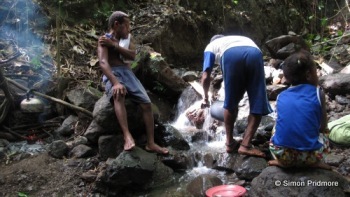
Light footed Papuans are natural guides in birding.
Eventually the rain stopped, the guide hacked out a two-metre length of green bamboo for each of us, sharpening one end so we could use it as a crutch to support us and prevent us from slipping too frequently on our descent of the mountain. The mud and leaves slid beneath our feet as we walked but the tree roots on the path were the most dangerous things to step on as the combination of rain and algae made them as slick as ice.
Our path descended so steeply that we were often level with the forest canopy of the slope below us. At one point, above a vertiginous drop, the guide stopped suddenly, pointing at a tree top about twenty metres away. First we saw one hornbill, possibly Blyth's, then another and then about a dozen, all squatting on the upper branches. We watched entranced as, one after another, the hornbills lifted themselves awkwardly off their perch and flapped away with a crashing, whooshing and clattering of enormous wings.
On our return to the guide’s village, we thanked him and paid him the agreed amount for his services. Following up on a promise made earlier in the day while we were chatting by the river, he gave us a demonstration of the traditional Papuan method of making fire using a flint, a bamboo stick and some dry grass. As a farewell gift, he presented us with a fire-making kit of our own, generosity from someone who, as his home clearly showed, owns very little. The otherwise bare, unpainted wall of the reception room was decorated with a chart of the Euro 2012 match schedule with the every score filled in and a poster of Javier Hernandez, the Mexico and Manchester United striker. We pointed, smiled and exchanged a few names. This produced more smiles. Even here, football is the universal language!
The writer Simon and his wife Sofie were helped and guided on their quest for paradise birds by Charles Roring, who lives in Manokwari and is an enthusiastic advocate and organiser of tours that involve and benefit local villagers. Contact Charles via http://manokwaripapua.blogspot.com/
Getting There
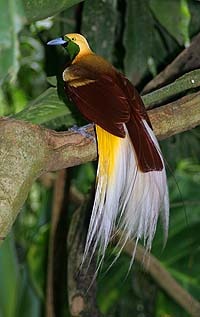
Lesser Bird of Paradise (what we were looking for) Source: Wikipedia
We stayed in Manokwari, which is served by daily hopper flights originating in Makassar in South Sulawesi. Makassar is an international entry point to Indonesia, with daily flights available from Singapore. Entry is visa free for ASEAN nationals; citizens of most other countries can buy a visa on arrival, (currently USD25.00 for a thirty day stay.)